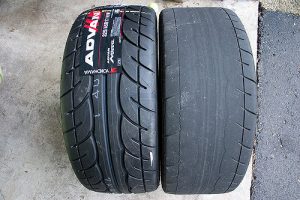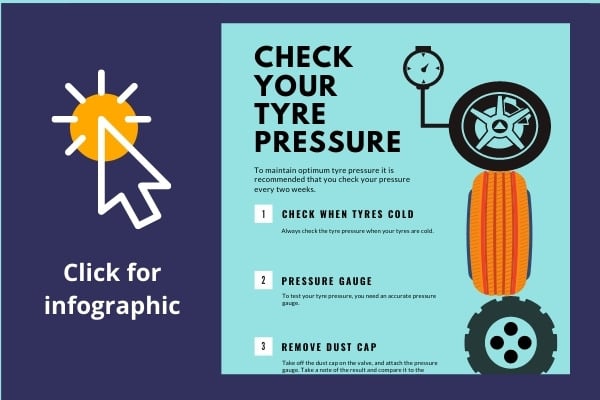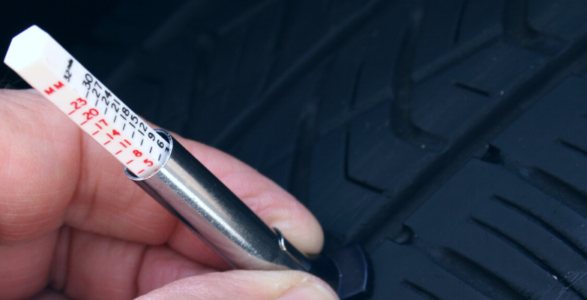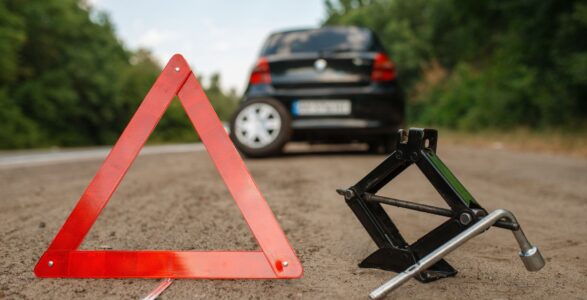Bald Tyres: Warning Signs, Risks, Causes and Prevention

Last updated 11 July 2022 | Published 2 March 2017
Tyre tread depth is a crucial component to driving safely as it provides grip to the road surface. It’s the tyre’s tread that provides the traction you rely on for a safe and smooth drive. As the miles add up, it wears down. Enough wear and you have bald tyres.
Many motorists are unaware of the dangers of driving on bald tyres.
What is a Bald Tyre?
A bald tyre is one that has seen so much use that its rubber has gradually been worn down through contact with the road, reducing tread depth to a dangerously low level and exposing the tread wear bars. In the worst cases, a bald tyre might have no tread at all and will be smooth
Bald Tyre Warning Signs
Recognizing the signs can help drivers know when their tyres are going bald and make them aware of when replacement is needed.
Visible Wear Bars
Once the tread is completely worn, tyre wear bars (“Treadwear Indicators” in engineering-speak) become more noticeable. They’re about the width of a pencil, and they run across the base of the tread from side to side. They’re most obvious once the tread depth reaches 2/32”.
If the tread is worn down to the treadwear indicators the tyre is no longer safe or legal for use and must be replaced.

Seeing Low Tread
If it appears the tread is heavily worn, you may check it with this simple and effective tread check at home:
A 20p coin has a border which measures 3mm. Insert a 20p coin into the lowest tread depth of your tyres. If you can’t see the outer rim around the edge of the coin, then your tyre is safe. If you can see the rim then your tyre tread is less than 3mm and should be replaced.
Manufacturers and safety experts believe the 1.6mm legal minimum is insufficient to guarantee safety. Therefore most recommend a minimum tread depth of 3mm.
Cracks and Bulges
You should perform an overall visual inspection of your tyres periodically, especially if you feel or hear anything unusual from them when driving. Look for cracks or cuts deep enough to expose the steel belts or body cords. Also check for unusual bulges in the tread or sidewalls – they could be a sign of internal damage. If you notice something that you’re not sure of, don’t hesitate to take it to a professional to have it checked.
Risks and Dangers of Bald Tyres
Aquaplaning
Having no tread on a tyre means that there is no way the water can evacuate from a tyre, rather it will create a lubricated film across the tyre and the road. So without tread, a tyre will slip and slide during wet and snowy conditions.
Poor Brakes
When driving, a vehicle’s brakes are trusted to work no matter the speed. But brakes don’t provide traction, tyres do. So, when driving on anything other than a perfectly smooth road free of sand, dirt and debris, bald tyres compromise your brakes’ ability to stop by providing reduced traction Poor braking efficiency increases the chance of being involved in an accident, plus adds unwanted repair costs.
Poor Fuel Efficiency
The second danger is that bald tyres lose pressure extremely quickly.
This, in turn, will affect how fuel-efficient the vehicle is and the performance of it.
Punctures
Tyres with less than the minimum tread are more susceptible to tyre punctures. This is because greater tread depth tyres feature grooves and sipes that provide a certain amount of protection from glass and other road debris.
Read more: A Guide to Tyre Repair Kits
Blowouts
Bald tyres can cause unsafe heat build-up. Tyres with good tread help to prevent massive heat buildup as the tyres are continuously in contact with the road. This is due to the treads allowing air to circulate through the grooves of a tyre. However, bald tyres have no tread and therefore, the airflow will be significantly reduced, which can lead to tyre blowouts.
Bald Tyre Causes and Prevention
A tyre’s tread wears down with each mile driven, and there are various factors that affect how quickly it wears. Knowledgeable drivers are proactive in tyre care and can prevent the risk of driving on bald tyres.
Underinflated and Overloaded Tyres
It’s the air inside the tyre that carries the weight of the vehicle. A tyre without enough air to carry the load is considered “under-inflated”. This is bad because it causes a lot more stress on the tyre than it was designed for. A tyre carrying a load greater than it was designed for is considered “overloaded”. Just like the under-inflated tyre , it’s subject to higher stresses than it was engineered for. In both cases, the result is reduced treadwear, and in extreme situations the tyre could fail, which people often refer to as a “blowout”.
Unbalanced and Misaligned Tyres
Tyres and wheels often have areas that are a bit heavy or light. “Balancing” the tyre /wheel assembly involves the use of a machine which tells the technician to add weight in specified places to make the tyre /wheel’s weight equal all over. If this isn’t done, the tyres may not wear evenly, and the driver may feel a vibration at higher speeds.
Alignment is important because car makers design the suspension so that tyres will roll properly for stable handling, strong traction and good treadwear. When the suspension gets out of specification it’s described as being “out of alignment”. That means the tyres are no longer rolling straight; they’re rolling at an angle instead of straight ahead or are tilted from vertical. This often results in increased treadwear, uneven treadwear, and in some cases, the car “pulling” to the left or right.
Neglected Tyre & Vehicle Maintenance
Keeping up with the proper maintenance helps a driver to be more aware of when tyres are wearing. Neglecting tyre maintenance increases the chance of driving on unaligned, underinflated, or unbalanced tyres, which, in the end, may result in driving on bald tyres.

Compass Vehicle Services Ltd offer:
nationwide car leasing – bad credit car finance – used car deals – personal leasing – business car leasing – best car lease deals – non-status car leasing
Back to all help and advice articles







